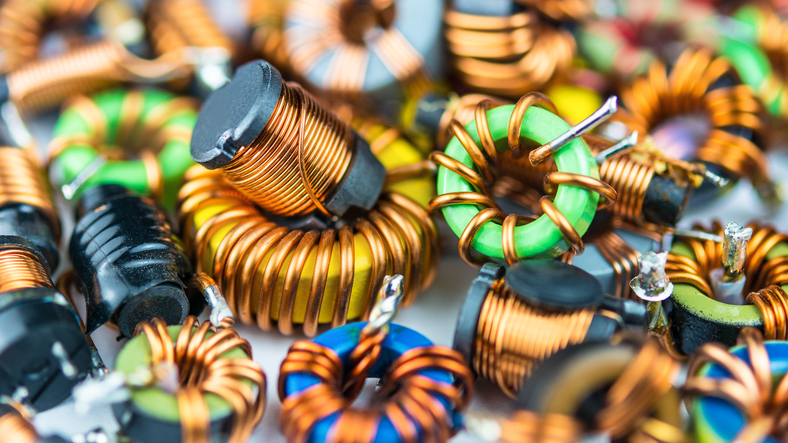
Engineers have always needed to plan ahead to be able to meet their electronic component needs in a timely manner, but as the industry faces fast-growing demand, doing so is more critical than ever.
The electronic power component industry has seen increasing lead times and power supply shortages in recent years, which have forced engineers to start planning earlier to complete their work.
Some components are now associated with high allocation risk, meaning they are likely to be allocated. Allocated inventory is inventory which is in storage, but is not available because it has been reserved for a specific purpose. Existing orders take up all of the available components so new orders cannot be fulfilled quickly. Parts that have excessively long lead times are, in effect, allocated.
Quick Navigation:
- Rapid Growth in Electronics Component Market
- Core Components of a Power Supply
- Causes of Shortages
- Strategies for Procurement
- Why Counterfeits Aren’t a Good Alternative
- How To Avoid Counterfeits
The Rapid Growth of the Electronics Component Market
How much has the market grown to cause these impacts? From 2014 to 2018, the global total available market for electronic components increased from $303 billion to $363 billion in U.S. dollars. The global electronics industry from 2016 to 2018 grew by an estimated four percent in 2017 and is expected to grow another four percent this year. A recent report forecasts that the electronic components industry will have a compound annual growth rate of five percent over the next five years.
At the same time, the industry has experienced expanding lead times for many types of components. The lead on some parts has reached a year, while in other cases it has stretched out even further, to as long as 90 weeks.
In many cases, these trends have led to increased costs for raw materials. The price of copper, for example, this January, reached its highest level since quarter one of 2014. This was due in large part to the demand surge for copper as a material for electronic components.
What these trends tell us is how important it is for procurement professionals to understand changing power supply market conditions and availability when planning projects for the future. Procurement of products, such as power supplies, which rely on electronics components, is more challenging than ever. These challenges make it increasingly important to plan ahead for projects requiring electronics components. Purchasing agents representing private and public sector organizations will lose ground against their competition if they don’t take these additional costs and lead times into account.
Core Components of a Power Supply
Power supplies such as AC-DC converters rely on electronic components. These power supplies convert alternating current (AC) voltage to direct current (DC) voltage. The electronic circuit known as a “power supply unit” must perform this task reliably for a piece of electronic equipment to function correctly.
A power supply unit consists of four core components. Let’s take a look at each of them before delving into power supply component availability.
1. The Transformer
The transformer is used to step the AC voltage up and down as well as provide isolation between the electronic system and the AC power. It transfers electrical energy between the primary winding and secondary winding, and it does so without changing the frequency. The transformer’s primary winding connects to the ac voltage source, while the secondary one correlates to the load. The two windings aren’t physically connected, but there is an induced voltage in the secondary winding in accordance with Faraday’s law.
2. The Rectifier
The rectifier is responsible for changing AC power to pulsating DC power. The basic rectifier is a diode — that is, a unidirectional device operating as a rectifier in the forward direction. The half-wave, the full-wave bridge type, and the full-wave center-tapped are the three basic rectifier circuits that use diodes.
3. The Filter
The filter changes the pulsating DC produced by the rectifier to a smooth DC level. It suppresses ripple, which is the AC component in a signal following rectification. High ripples can damage the load. There are two main types of filters for power supplies: C-filters and RC-filters. C-filters are the simplest version of the two.
4. The Regulator Circuits
The voltage regulator helps ensure that the DC output voltage is steady regardless of any variation in the input voltage, which enables the load to operate properly. The most common types of regulators are the series voltage regulator and the shunt voltage regulator.
Causes of Shortages in Electronic Component Supply
The electronic components industry is marked by rising demand and a supply chain that is struggling to keep up. The current surge in demand for electronics components has even exceeded earlier projections of rapid growth, and shows no sign of slowing down. This increased demand has affected many of the sectors that rely on electronic components, such as power supply manufacturing. Some of the parts most affected by these issues include tantalum and ceramic capacitors, frequency control products, and ferrite beads.
A shortage of power supply is not a new phenomenon. Ensuring that supply matches demand is a challenge. For the past three years, however, the PSU shortage has escalated greatly in the electronics component industry.
So, what’s causing this increased demand? Today, various sectors of the economy are using more electronic components than ever before, and some sectors that hardly ever used electronics in the past are now beginning to incorporate them. Even consumer products that didn’t require electronics components in the past, now require electronics components for their increasingly complex configurations.
These smart devices are part of the Internet of Things, the network of internet-connected, smart devices that can talk to one another to optimize their performance. Everything from refrigerators to security cameras to doorbells can now be “smart”, which means they require electronic components.

Another sector using increasing numbers of electronic components is the auto industry. As cars get smarter, the companies that make them need to compete with consumer electronics companies and others that previously used many more components than the auto industry. In addition to the growing number of components automakers use, demand for cars is quickly rising in third-world countries, further boosting component demand.
The manufacturing sector has seen an uptick in recent years as well. It is also using a growing number of electronics for computers and industrial equipment. The mobile and computer industries have seen growth too.
If supply increased to match this growing demand, there would be no problem — but global supply markets for electronics components are struggling to meet demand. Major players in the electronics components industry simply have not made the capital investment needed to meet demand.
Many manufacturers of electronic components have also struggled to get enough raw materials to make the parts they need.
More customers may also be double-ordering their components. Customers are likely ordering more than they need in order to ensure they get their components on time, but this could be exacerbating the shortage. A recent Morgan Stanley report found that double-ordering was at an all-time high in quarter four of 2017.
Strategies for Procurement
These supply issues have caused a situation in which distributors fill the orders of existing customers first: large original equipment manufacturers (OEMs) and other key customers. New customers may find it difficult to break into the receiving line and get the components they need.
Many distributors have also started to put more resources into analyzing and predicting power supply trends so they can adjust to meet changing demand. Some have people whose job is to work daily on this task, and some have segmented their purchasing organization to enable them to better manage supply to meet demand.
So, on the customer side, how can engineers and procurement professionals ensure they get the parts they need? There are various strategies that may help with this.
Perhaps the most important step to take is to plan properly for future projects. Procurement teams need to start planning further in advance. In fact, long lead times for electronic components virtually force them to extend their planning periods. Doing so can help ensure a steady flow of the parts they need.
Procurement professionals can use this planning information to create schedules of orders as well as forecasts of their expected demand. Providing this data to distributors well in advance of when they need the parts can help ensure they get what they need on time, because distributors can plan it into their supply chains. In the current environment, planning far ahead is crucial.

Frequent and detailed communication between suppliers and distributors is key to working through electronics component shortages. It can help both sides plan for the future, anticipate potential problems, and agree on alternatives if the original plans don’t work out. Suppliers should frequently provide distributors with updated demand forecasts and distributors should keep their customers updated on relevant supply and ordering information.
Some engineers are also turning to alternative suppliers to meet their component needs. Companies may need to expand their approved vendor list and start buying from more distributors than they usually do, including both franchised and independent ones. They should always, of course, make sure these distributors are reputable, but putting time into finding new places to buy components may be necessary.
One way to do this is to look for component manufacturers that don’t typically supply your industry but could provide the parts you need. Companies may also need to explore whether working with newer, smaller component manufacturers is feasible.
Companies are also looking for substitutes for the parts they typically use. Switching a common part for one that’s not in high demand can ease procurement difficulties. Sometimes, this switch will be relatively straightforward. At other times, it may require a redesign. This extra work, however, may be worth it if you can’t find the components you typically use, as long as performance is not sacrificed.
Applications For Power Supplies
Why Counterfeit Materials Are Not a Good Alternative
Another problem that has cropped up due to these procurement challenges is a surge of counterfeit parts.
Engineers are being forced to turn to new vendors, and high demand means lots of opportunities for counterfeiters. While obtaining these counterfeit electronic components appears to solve procurement issues, it can lead to many other problems in the future. Because most companies don’t realize they’re receiving counterfeit parts, it’s critical that they learn how to identify them and avoid them.
Counterfeit parts can come in numerous forms. Counterfeiters may apply the markings of a manufacturer to an item that the manufacturer did not make. They may be old parts marketed as new or nonfunctional parts sold as functional. They could also be out of spec or reproduced, but with tampered designs that can cause security breaches.
Using counterfeit parts can result in safety and security issues, economic losses, and poor equipment performance.
Because counterfeits do not come with any performance guarantees, you cannot be sure how they will function. Often, they are of lower quality than OEM parts and may even be damaged on arrival. This can lead to poor performance and even total equipment failure. Tracing this failure back to the component can be challenging.
These malfunctions can lead to safety issues. The component could cause safety hazards directly by malfunctioning, or perhaps by short-circuiting and causing a fire. It could also indirectly result in harm if it causes the product to fail or malfunction.
Counterfeits can also lead to economic losses, as customers will end up returning malfunctioning equipment. Liability for injury can also be expensive. Reports suggest that consumer and industrial businesses are losing around $250 billion every year due to counterfeit electronic parts.
So How Can Companies Avoid Counterfeits?
Conducting a quality inspection of all incoming parts can substantially reduce the risk of accidentally using a fake part in a product. You can either perform these inspections in-house or hire an outside company to conduct them for you. You might need to be especially stringent in your checks if you recently started purchasing from a new supplier or have reason to believe there’s an unusually high risk for counterfeits.
You should also have processes in place to ensure that the companies you buy from are reputable. Original component manufacturers, franchised suppliers, and authorized suppliers are typically safe if they have a good reputation. When you’re working with independent suppliers, you will need to be especially careful. Check their references and reviews as well as any certifications they have.
Planning ahead can help you avoid counterfeits as well, since it gives you time to review your suppliers more thoroughly. For instance, you should create a plan for when components become obsolete, as you will no longer be able to obtain them from the original manufacturer, which increases the chances you’ll encounter a counterfeit.
Expected Future Trends for Power Supply Components and Electronic Components
Predictions vary as to when supply will be able to better align with demand. Demand growth is expected to continue through 2018 but slow down compared to growth in 2017. Inventory levels are rising across the industry, but many customers are still waiting to feel the effects of that increase.
Supply and demand will eventually level out — at least relatively so. Some believe this will happen in 2019, although we will have to wait and see to know for sure. Prices will likely need to increase to help bring the electronics component shortage to an end. Time is another critical factor. These supply issues can’t be solved overnight, but they will even out at some point, and hopefully in the near future.

In the face of this uncertainty, companies that need electronic components should continue to anticipate long lead times. They must continue to refine their procurement strategies and plan ahead, now, for 2019 and perhaps even 2020. With proper planning and continuous vigilance regarding demand trends and supply needs, you can help ensure you get the components you need.
Power Supply Component Experts
Interested in guidance through component shortages? Contact ACT for power supply systems and support.